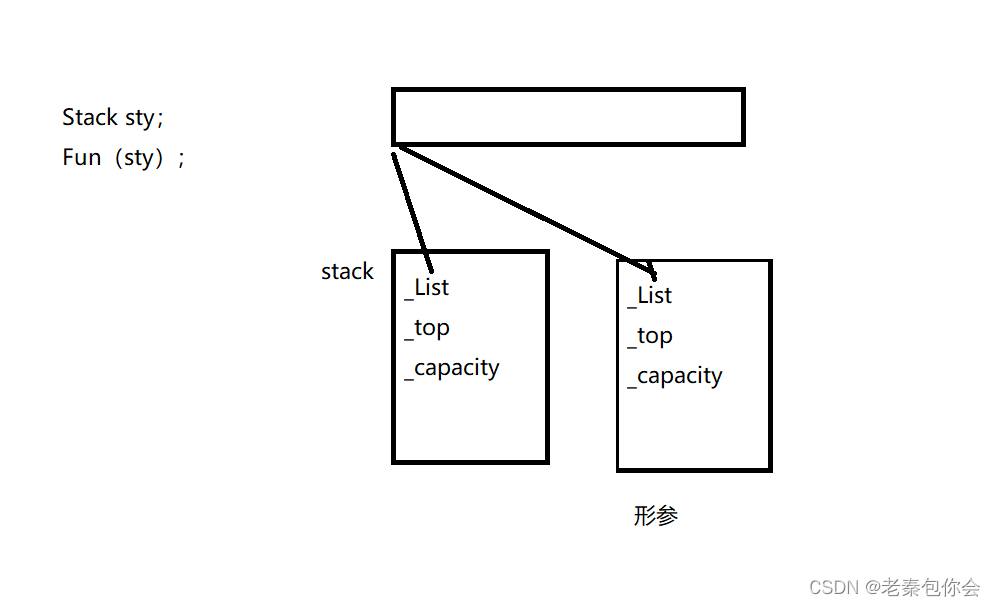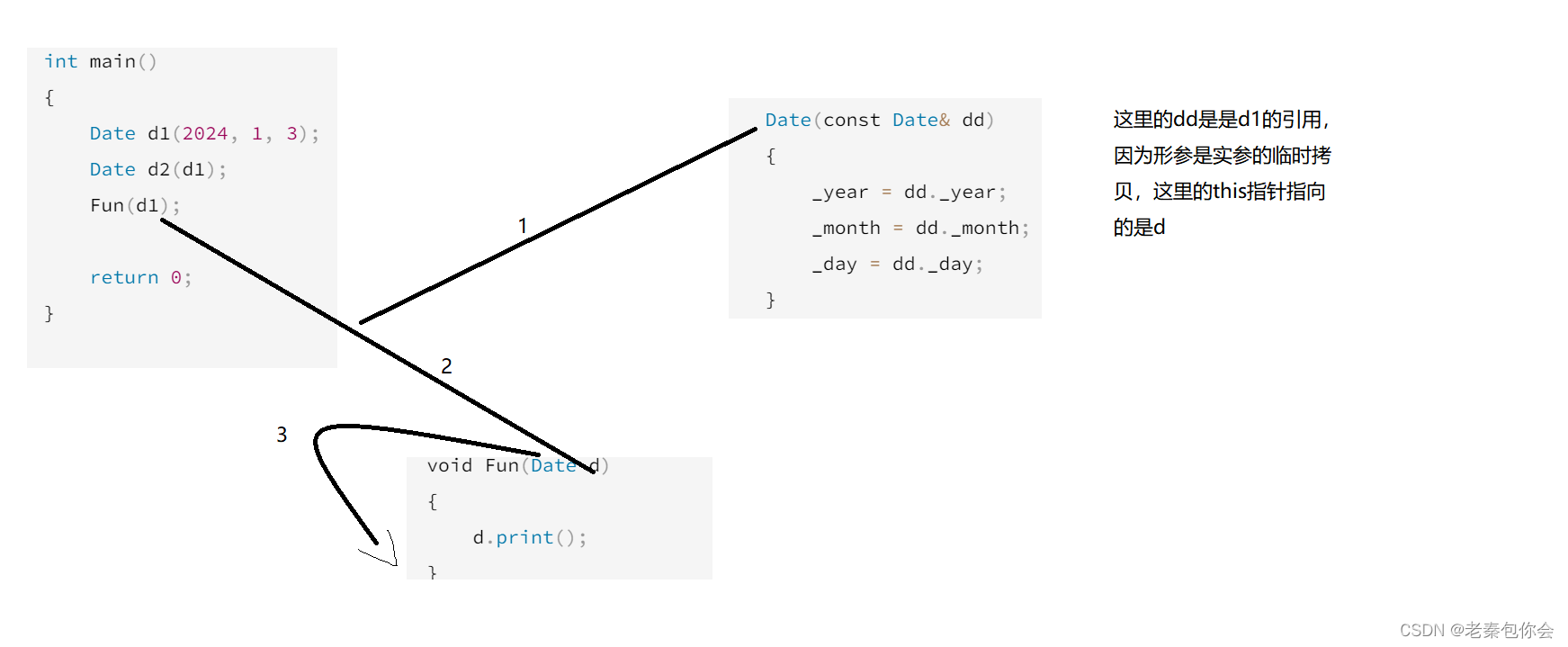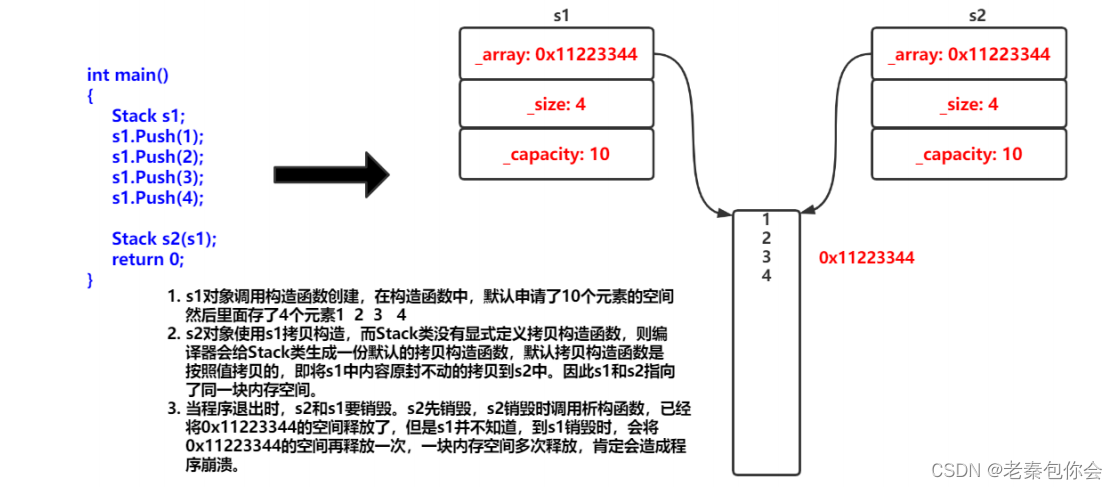作者前言
🎂 ✨✨✨✨✨✨🍧🍧🍧🍧🍧🍧🍧🎂
🎂 作者介绍: 🎂🎂
🎂 🎉🎉🎉🎉🎉🎉🎉 🎂
🎂作者id:老秦包你会, 🎂
简单介绍:🎂🎂🎂🎂🎂🎂🎂🎂🎂🎂🎂🎂🎂🎂🎂
喜欢学习C语言、C++和python等编程语言,是一位爱分享的博主,有兴趣的小可爱可以来互讨 🎂🎂🎂🎂🎂🎂🎂🎂
🎂个人主页::小小页面🎂
🎂gitee页面:秦大大🎂
🎂🎂🎂🎂🎂🎂🎂🎂
🎂 一个爱分享的小博主 欢迎小可爱们前来借鉴🎂
类和对象
- **作者前言**
- 默认成员函数
- 类的空类
- 构造函数
- 内置类型和自定义类的的自动初始化情况
- 析构函数
- 拷贝函数
- 拷贝函数的特征
- 赋值运算符重载
- 运算符重载
- 赋值运算符重载
- cout的流提取(<<)
- const成员函数
- 取地址及const取地址操作符重载
默认成员函数
默认成员函数:用户没有显式实现,编译器会生成的成员函数称为默认成员函数。

类的空类
我们在写类的成员变量和成员函数,我们实例化一个对象,有时候就会忘记实例化,直接使用成员函数,这个在C语言会报错,在c++就不会报错,但是值是随机的
#include<iostream>
using std::cout;
using std::endl;
using std::cin;
class Stru
{
public:void Fun(){cout << _a << endl;cout << _b << endl;}
private:int* _a;int _b;
};
int main()
{Stru str;str.Fun();return 0;
}
有啥方法可以解决呢?答案是构造函数
构造函数
构造函数是一个特殊的成员函数,名字与类名相同,创建类类型对象时由编译器自动调用,以保证
每个数据成员都有 一个合适的初始值,并且在对象整个生命周期内只调用一次。
构造函数是特殊的成员函数,需要注意的是,构造函数虽然名称叫构造,但是构造函数的主要任
务并不是开空间创建对象,而是初始化对象。
其特征如下:
- 函数名与类名相同。
- 无返回值。
- 对象实例化时编译器自动调用对应的构造函数。
- 构造函数可以重载。
#include<iostream>
using std::cout;
using std::endl;
using std::cin;
class Stru
{
public:Stru(){_a = 200;_b = 100;}Stru(int a, int b){_a = a;_b = b;}void Fun(){cout << _a << endl;cout << _b << endl;}
private:int _a;int _b;
};
int main()
{Stru str;str.Fun();Stru st1(1, 1);st1.Fun();return 0;
}
这里有两种写法,一种是直接使用自己定义的,一种是使用传入的参数,需要注意的是 第一种写法不用加(),因为加了就相当于是函数声明了。
注意:可以使用函数重载,但是要注意是否有冲突,缺省参数和无参数是否存在歧义。
如果类中没有显式定义构造函数,则C++编译器会自动生成一个无参的默认构造函数,一旦用户显式定义编译器将不再生成。
c++编译器默认构造函数:一般情况内置类型不会进行初始化,自定义类型的初始化会自动调用默认构造函数。
内置类型和自定义类的的自动初始化情况
#include<iostream>
using std::cout;
using std::endl;
using std::cin;
class Stack
{
public:Stack(){_a = (int *)malloc(sizeof(int) * 4);if (_a == nullptr){perror("malloc");return;}_top = 0;//栈顶元素的下一个_capacity = 4;}//插入void Stackpushback(int elemest){if (_top == _capacity){int size = _capacity > 0 ? 2 * _capacity : 4;int* tmp = (int*)realloc(_a, sizeof(int) * size);if (tmp == nullptr){perror("realloc");return;}_a = tmp;_capacity = size;}_a[_top++] = elemest;}//删除void Stackpop(){if(_top)_top--;}//栈顶元素int Stacktop(){if(_top)return _a[_top - 1];return INT_MAX;}//是否为空bool Stackempty(){return _top;}private:int* _a;int _top;int _capacity;};
class StackQueue
{
private://入数据的栈Stack pushstack;//出数据的栈Stack popstack;int size;};
int main()
{Stack mystack;StackQueue mq;return 0;
}

可以看到size没有初始化就赋值了0,因为在vs2019优化过了,我们一般就认为是没有初始化化的,
内置类型就是语言提供的数据类型,如:int/char…,自定义类型就是我们使用class/struct/union等自己定义的类型,看看下面的程序,就会发现编译器生成默认的构造函数会对自定类型成员_t调用的它的默认
注意一下:指针类型都是内置类型
但是在C++11就增加了补丁
**内置类型成员变量在类中声明时可以给默认值。**本质上还是声明,定义是要给空间的

总结:
- 我们不写构造函数,编译器会自己写一个构造函数,这个值是随机值,这个函数叫做默认构造
- 无参数构造函数可以叫默认构造
- 全缺省函数也叫默认构造
- 这三种不能同时存在,只能存在一个
析构函数
前面我们学习了构造函数,主要用于初始化对象
这里我们学习析构函数
析构函数:与构造函数功能相反,析构函数不是完成对对象本身的销毁,局部对象销毁工作是由
编译器完成的。而对象在销毁时会自动调用析构函数,完成对象中资源的清理工作。
析构函数是特殊的成员函数,其特征如下:
- 析构函数名是在类名前加上字符 ~。
- 无参数无返回值类型。
- 一个类只能有一个析构函数。若未显式定义,系统会自动生成默认的析构函数。注意:析构
函数不能重载 - 对象生命周期结束时,C++编译系统系统自动调用析构函数。
#include<iostream>
using std::cout;
using std::endl;
using std::cin;
class Date
{
public:~Date(){cout << "调用析构函数" << endl;}Date(){_a = 20;}
private:int _a = 30;
};
int main()
{Date time;return 0;
}
这个析构函数我们可以运用于经常忘记的内存释放的地方,比如栈使用结束后,空间释放

注意:析构调用完才销毁对象
拷贝函数
#include<iostream>
using std::cout;
using std::endl;
using std::cin;
class Date
{
public:Date(int year, int month, int day){_year = year;_month = month;_day = day;}void print(){cout << _year << "-" << _month << "-" << _day << endl;}
private:int _year;int _month;int _day;
};
void Fun(Date d)
{d.print();
}
int main()
{Date d1(2024, 1, 4);Fun(d1);return 0;
}
这种是一种浅拷贝,但是当浅拷贝运用到某些场景就会带来不必要的麻烦

当Fun函数运行的时候是有可能更改对应地址的值的
拷贝函数的特征
拷贝构造函数也是特殊的成员函数,其特征如下:
- 拷贝构造函数是构造函数的一个重载形式。
- 拷贝构造函数的参数只有一个且必须是类类型对象的引用,使用传值方式编译器直接报错,
因为会引发无穷递归调用。
#include<iostream>
using std::cout;
using std::endl;
using std::cin;
class Date
{
public:Date(int year, int month, int day){_year = year;_month = month;_day = day;}~Date(){cout << "调用析构函数" << endl;}Date(const Date& dd){_year = dd._year;_month = dd._month;_day = dd._day;}void print(){cout << _year << "-" << _month << "-" << _day << endl;}
private:int _year;int _month;int _day;
};
int main()
{Date d1(2024, 1, 3);Date d2(d1);return 0;
}

3. 若未显式定义,编译器会生成默认的拷贝构造函数。 默认的拷贝构造函数对象按内存存储按字节序完成拷贝,这种拷贝叫做浅拷贝,或者值拷贝。
#include<iostream>
using std::cout;
using std::endl;
using std::cin;
class Date
{
public:Date(int year, int month, int day){_year = year;_month = month;_day = day;}~Date(){cout << "调用析构函数" << endl;}Date(const Date& dd){_year = dd._year;_month = dd._month;_day = dd._day;}void print(){cout << _year << "-" << _month << "-" << _day << endl;}
private:int _year;int _month;int _day;
};
void Fun(Date d)
{d.print();
}
int main()
{Date d1(2024, 1, 3);Date d2(d1);Fun(d1);return 0;
}
这里的dd是是d1的引用,因为形参是实参的临时拷贝,这里的this指针指向的是d,
这个图也可以解释出,为啥拷贝函数传值会陷入无限的循环
- 深拷贝
#include<iostream>
using std::cout;
using std::endl;
using std::cin;
class Stack
{
public:Stack(int capacity = 3){_a = (int*)malloc(sizeof(int) * capacity);if (_a == NULL){perror("malloc");exit(-1);}_capacity = capacity;_top = 0;}//深拷贝Stack(const Stack& st){_a = (int*)malloc(sizeof(int) * st._capacity);if (_a == NULL){perror("malloc");exit(-1);}_capacity = st._capacity;_top = st._top;}
private:int *_a;int _top;int _capacity;
};
int main()
{Stack d1(5);Stack d2(d1);return 0;
}


创建两个一模一样的空间,深拷贝就是要进行一比一的复制,浅拷贝在这里会公用一块地址,
浅拷贝的示意图:

注意:类中如果没有涉及资源申请时,拷贝构造函数是否写都可以;一旦涉及到资源申请
时,则拷贝构造函数是一定要写的,否则就是浅拷贝。
简单的来说,如果涉及到地址就要考虑一下是否需要深拷贝,如是简单的拷贝值的化,拷贝函数可以写也可以不写,不写的话,编译器会默认构造一个拷贝函数,(浅拷贝)
#include<iostream>
using std::cout;
using std::endl;
using std::cin;
class Stack
{
public://构造函数Stack(int capacity = 3){_a = (int*)malloc(sizeof(int) * capacity);if (_a == NULL){perror("malloc");exit(-1);}_capacity = capacity;_top = 0;}//深拷贝Stack(const Stack& st){_a = (int*)malloc(sizeof(int) * st._capacity);if (_a == NULL){perror("malloc");exit(-1);}_capacity = st._capacity;_top = st._top;}//析构函数~Stack(){free(_a);cout << "释放了空间" << endl;_a = nullptr;_top = 0;_capacity = 0;}
private:int *_a;int _top;int _capacity;
};
class MyQueue
{
private:Stack _d1;Stack _d2;int _size = 0;};
int main()
{MyQueue q1;MyQueue q2(q1);//调用了拷贝构造return 0;
}
这里的情况就是q1会开辟成员变量的空间,调用了MyQueue的默认构造函数,然后_d1和_d2调用Stack的自定义的默认构造.


q1和q2之间的联系,之间调用的是拷贝函数,调用MyQueue的默认拷贝构造函数,而Stack调用的就是自定义的拷贝构造函数
一些场合
自定义当返回值
#include<iostream>
using std::cout;
using std::endl;
using std::cin;
class Stack
{
public://构造函数Stack(int capacity = 3){_a = (int*)malloc(sizeof(int) * capacity);if (_a == NULL){perror("malloc");exit(-1);}_capacity = capacity;_top = 0;}//深拷贝Stack(const Stack& st){cout << "拷贝" << endl;_a = (int*)malloc(sizeof(int) * st._capacity);if (_a == NULL){perror("malloc");exit(-1);}_capacity = st._capacity;_top = st._top;}//析构函数~Stack(){free(_a);cout << "释放了空间" << endl;_a = nullptr;_top = 0;_capacity = 0;}
private:int *_a;int _top;int _capacity;
};
class MyQueue
{
private:Stack _d1;Stack _d2;int _size = 0;};
Stack fun()
{Stack d1;return d1;
}
int main()
{fun();return 0;
}

可以看出返回值,不会直接返回d1,而是d1的拷贝,也就是d1的临时对象
如果换成
Stack& fun()
{static Stack d1;return d1;
}


可以把图中的Test函数换成我们的fun函数,看懂了就可以了。
为了提高程序效率,一般对象传参时,尽量使用引用类型,返回时根据实际场景,能用引用尽量使用引用。
赋值运算符重载
运算符重载
前面我们学习C语言,知道内置类型(int 、char…)可以直接使用各种运算符,但是自定义类型是不可以的
#include<iostream>
using std::cout;
using std::endl;
using std::cin;
class Date
{
public://构造函数Date(int year, int month, int day){cout << "构造函数" << endl;_year = year;_month = month;_day = day;}//浅拷贝Date(const Date& d1){cout << "拷贝" << endl;_year = d1._year;_month = d1._month;_day = d1._day;}//析构函数~Date(){cout << "析构函数" << endl;}int _year;int _month;int _day;
};
//相等
bool Equal(Date x, Date y)
{return x._year == y._year&& x._month == y._month&& x._day == y._day;
}
//大于
bool Greater(Date x, Date y)
{if (x._year > y._year){return true;}else if (x._year == y._year && x._month > y._month){return true;}else if (x._year == y._year && x._month == y._month && x._day > y._day){return true;}elsereturn false;
}
int main()
{Date a(2024,1,3);Date b(2024, 1, 5);cout << Equal(a, b) << endl;return 0;
}

我们如果要比较这些自定义类型就有可能要写成函数,但是不太方便,所以c++改变了一些
C++为了增强代码的可读性引入了运算符重载,运算符重载是具有特殊函数名的函数,也具有其返回值类型,函数名字以及参数列表,其返回值类型与参数列表与普通的函数类似。
函数名字为:关键字operator后面接需要重载的运算符符号。
函数原型:返回值类型 operator操作符(参数列表)
//相等
bool operator==(Date x, Date y)
{return x._year == y._year&& x._month == y._month&& x._day == y._day;
}
//大于
bool operator>(Date x, Date y)
{if (x._year > y._year){return true;}else if (x._year == y._year && x._month > y._month){return true;}else if (x._year == y._year && x._month == y._month && x._day > y._day){return true;}elsereturn false;
}
函数名就更改过成这样的,使用这个函数方法有两种,一种是直接写函数名直接调用
另一种

这里使用a ==b 就是 operator==(x, y)的简写,需要注意的是 << 的优先级比 == 、>…高。
函数重载和运算符重载两者毫不相关,函数重载允许参数不同的同名函数,而运算符重载允许自定义类型直接使用运算符
我们还可以在类里面写
#include<iostream>
using std::cout;
using std::endl;
using std::cin;
class Date
{
public://构造函数Date(int year, int month, int day){cout << "构造函数" << endl;_year = year;_month = month;_day = day;}//浅拷贝Date(const Date& d1){cout << "拷贝" << endl;_year = d1._year;_month = d1._month;_day = d1._day;}//析构函数~Date(){cout << "析构函数" << endl;cout << _year << '-' << _month << '-' << _day << endl;}//相等bool operator==(Date& y){return _year == y._year&& _month == y._month&&_day == y._day;}
private:int _year;int _month;int _day;//大于bool operator>(Date& y){if (_year > y._year){return true;}else if (_year == y._year && _month > y._month){return true;}else if (_year == y._year && _month == y._month && _day > y._day){return true;}elsereturn false;}void exchengtime(int* a){if ((_year % 4 == 0 && _year % 100 != 0) || (_year % 400 == 0))a[2] = 29;elsea[2] = 28;}Date& operator+=(int day)//这里返回引用是防止对象拷贝返回{int a[] = { 0,31,28,31,30,31,30,31,31,30,31,30,31 };_day += day;exchengtime(a);while (_day > a[_month]){_day -= a[_month];_month++;if (_month > 12){_year++;exchengtime(a);_month %= 12;}}return *this;}
};
int main()
{Date a(2024,1,3);Date b(2024, 1, 5);cout << (a == b) << endl; // a.operator==(b) -> a.operator==(&a, b)a += 363;return 0;
}
赋值运算符重载
有时候就是我们会看见到i = 5; j = 20;
我们有时需要对对象进行赋值
#include<iostream>
//using namespace std;
using std::cout;
using std::endl;
using std::cin;
class Date
{
public://构造函数Date(int y, int m, int d){_year = y;_month = m;_day = d;}//拷贝Date(const Date& d1){_year = d1._year;_month = d1._month;_day = d1._day;}//析构函数~Date(){cout << _year << endl;cout << _month << endl;cout << _day << endl;}Date& operator=(const Date& d1){//防止自己给自己赋值(特别是深拷贝的时候)if (this != &d1){_year = d1._year;_month = d1._month;_day = d1._day;}return *this;}
private:int _year;int _month;int _day;
};
int main()
{int a = 10;cout << a << endl;Date d1(2024, 1, 15);Date d2(2024,1,16);Date d3(2024,1,17);d3 = d1 = d2;return 0;
}
这样就可以不使用到拷贝构造,
还需要注意的是operator=是默认成员函数,不写编译器会默认生成,跟拷贝构造的行为类似,对内置类型进行值拷贝,自定义类型调用他的赋值
赋值运算符重载格式:
1. 参数类型:const T&,传递引用可以提高传参效率
2. 返回值类型:T&,返回引用可以提高返回的效率,有返回值目的是为了支持连续赋值
3. 检测是否自己给自己赋值
4. 返回*this :要复合连续赋值的含义
全部代码总和:
test.h
#pragma once
#include<iostream>
#include<assert.h>
using std::cout;
using std::endl;
using std::cin;
class Date
{
public://构造函数Date(int y = 2024, int m = 1, int d = 15);//拷贝Date(const Date& d1);//析构函数~Date();int Getmonthday(int year, int month);bool operator<(const Date& d1);bool operator>(const Date& d1);bool operator==(const Date& d1);bool operator<=(const Date& d1);bool operator>=(const Date& d1);Date& operator=(const Date& d1);Date& operator+=(int day);Date operator+(int day);private:int _year;int _month;int _day;
};
test.cpp
#include"Date.h"
Date::Date(int y, int m, int d)
{_year = y;_month = m;_day = d;if (_year < 0 || _month < 1 || _month >12 || _day > Getmonthday(_year, _month) || _day < 0){cout << _year << "-" << _month << "-" << _day << endl;cout << "非法日期" << endl;exit(-1);}}
int Date::Getmonthday(int year, int month)
{int monthday[] = { 0,31,28,31,30,31,30,31,31,30,31,30,31 };if ((year % 4 == 0 && year % 100 != 0) || (year % 400 == 0)){monthday[2] = 29;}return monthday[month];}
//拷贝
Date::Date(const Date& d1)
{_year = d1._year;_month = d1._month;_day = d1._day;
}
//析构函数
Date::~Date()
{cout << _year << endl;cout << _month << endl;cout << _day << endl;
}
Date& Date::operator=(const Date& d1)
{//防止自己给自己赋值(特别是深拷贝的时候)if (this != &d1){_year = d1._year;_month = d1._month;_day = d1._day;}return *this;
}
Date& Date::operator+=(int day)
{*this = *this + day;return *this;
}
Date Date::operator+(int day)
{Date tmp(*this);int monthday[] = { 0,31,28,31,30,31,30,31,31,30,31,30,31 };tmp._day += day;if ((tmp._year % 4 == 0 && tmp._year % 100 != 0) || (tmp._year % 400 == 0)){monthday[2] = 29;}else{monthday[2] = 28;}while (tmp._day - monthday[tmp._month] > 0){tmp._day -= monthday[tmp._month];tmp._month++;if (tmp._month > 12){tmp._month %= 12;tmp._year++;if ((tmp._year % 4 == 0 && tmp._year % 100 != 0) || (tmp._year % 400 == 0)){monthday[2] = 29;}else{monthday[2] = 28;}}}return tmp;}
bool Date::operator<(const Date& d1)
{if (_year < d1._year){return true;}if (_year == d1._year && _month < d1._month){return true;}if (_year == d1._year && _month == d1._month && _day < d1._day){return true;}return false;}
bool Date::operator==(const Date& d1)
{return _year == d1._year && _month == d1._month && _day == d1._day;
}
bool Date::operator<=(const Date& d1)
{return (*this) < d1 || (*this) == d1;
}
bool Date::operator>(const Date& d1)
{return !((*this) <= d1);
}
bool Date::operator>=(const Date& d1)
{return !((*this)< d1);
}test1.cpp
#include"Date.h"
int main()
{Date d1(2024, 1, 3);Date d2(2024,1,16);Date d3(2020,1,17);int a = d1 == d2;cout << a << endl;a = d1 >= d2;cout << a << endl;a = d1 <= d2;cout << a << endl;d3 += 366;return 0;
}需要注意的是代码中的**operator+(int day)**函数 和 **operator+=(int day)**函数的效率是很低效的

这张图里面可以说明,上图的代码的对象拷贝是次数多,造成了效率的低效,
对象的赋值进行了一次拷贝对象
*this + day 创建了一个临时的 Date 对象,表示当前对象的值加上 day 天的结果。*this = … 将上面提到的临时对象的值赋给了当前对象 *this。这个赋值操作涉及到对象的拷贝。赋值操作符 = 的行为是根据类的定义而定的,,它会执行对象的成员逐个拷贝。
实现 - 和-=
这里的实现方法和上面的方法是不一样的,
Date& Date::operator-=(int day)
{_day -= day;int monthday[] = { 0,31,28,31,30,31,30,31,31,30,31,30,31 };if ((_year % 4 == 0 && _year % 100 != 0) || (_year % 400 == 0)){monthday[2] = 29;}else{monthday[2] = 28;}while (_day <= 0){_month--;if (_month <= 0){_year--;if ((_year % 4 == 0 && _year % 100 != 0) || (_year % 400 == 0)){monthday[2] = 29;}else{monthday[2] = 28;}_month = 12;}_day += monthday[_month];}return *this;}
Date Date::operator-(int day)
{Date tmp(*this);tmp -= day;return tmp;}
可以看看这里,这里的情况就是,在operator-函数里面套用operator-=,这样的效率就变高了
实现++
前置++
Date& Date::operator+=(int day)
{_day += day;int monthday[] = { 0,31,28,31,30,31,30,31,31,30,31,30,31 };if ((_year % 4 == 0 && _year % 100 != 0) || (_year % 400 == 0)){monthday[2] = 29;}else{monthday[2] = 28;}while (_day - monthday[_month] > 0){_day -= monthday[_month];_month++;if (_month > 12){_month %= 12;_year++;if ((_year % 4 == 0 && _year % 100 != 0) || (_year % 400 == 0)){monthday[2] = 29;}else{monthday[2] = 28;}}}return *this;
}
Date& Date::operator++()
{*this += 1;return *this;
}
后置++
后置++不能和上面写的一样,因为要构成重载,我们只能从参数那里下手,不然就会无法构成重载,
Date Date::operator++(int)
{Date tmp(*this);*this += 1;return tmp;}
编译器链接的时候,函数的名字只和函数的名字和函数的参数类型有关,跟函数的形参名字没有关系。
就是说c++的函数在链接的时候有自己的函数名修饰规则,

cout的流提取(<<)
小解释
我们在使用std::cout的打印不同类型是不需要和C语言写出格式符,

我们使用iostram头文件,主要就是里面定义了对象,
我们顺着点击


就会看到下图

可以看到定义了很多函数,简单的来说就是函数重载,类型匹配,进而就解释了cout支持流提取,cout是一个对象,
那我们来函数重载一个流提取
void Date::operator<<(ostream& out)
{out << _year << "-" << _month << "-" << _day << endl;
}
out相当于我们把std::cou传入,
cout的小例子
我们有时候在使用cout打印一个自定义类型的变量时,会出错,例如
Date A;//Date是一个类,A是对象
cout<<A;
如果我们这样写的话会报错,因为cout的类方法是没有写这样的双操作数运算符符重载的,
如果我们按照刚刚写的日期类的流提取的函数重载,
可以这样

这样可以正常输出,因为双操作数运算符的第一个参数是左操作数,第二个参数是右操作数,我们这个日期类的流提取函数重载的第一个参数就是this这个隐藏的参数
void Date::operator<<(Date * const this ,ostream& out)
这样实现的话虽然没有错,但是不方便理解,运算符重载也没有规定在类之外不能进行重载,所以我们可以在类外进行运算符重载
void operator<<(ostream& out, const Date& A)
{out << A._year << "-" << A._month << "-" << A._day << endl;
}
需要把Date的类成员进行public权限才能成功运行
友元函数
或者我们可以写一个友元函数
友元函数 :既可以是不属于任何类的非成员函数,也可以是另一个类的成员函数 ,统称为友元函数
//友元函数
friend void operator<<(ostream& out, const Date& A)
{out << A._year << "-" << A._month << "-" << A._day << endl;
}
这个函数是在类定义的,但是不是成员函数,
如果在类之外定义不用加Data::这个
我们还知道
cout << a<< b<<endl;
支持这样的上面写的不支持,如果要改动,就把返回类型改为ostream&

这样就可以支持了
流插入
//流插入friend istream& operator>>(istream& out, Date& A){out >> A._year;out >> A._month;out >> A._day;cout << A;return out;}
小总结
一般的运算符一般实现成成员函数,而流插入和流提取必须实现全局,这样才能让流对象作为第一个参数.
流是为解决自定义类型的输入和输出问题,C语言的printf 、scanf只能解决内置类型,无法解决自定义类型的输入输出问题
const成员函数
我们在C语言知道,const修饰的变量是改变不了,如果是强行改变那就另当别论了,需要注意的是权限可以平移和缩小,但是不能放大,也就是说,const修饰的变量可以传参给const修饰的变量(权限平移), 非const修饰的变量可以传参给const修饰的变量(权限缩小), 但是不能const修饰的变量可以传参给非const修饰的变量(权限放大)
那么在cpp中是怎么使用const,会有怎么样的效果呢?
将const修饰的“成员函数”称之为const成员函数,const修饰类成员函数,实际修饰该成员函数隐含的this指针,表明在该成员函数中不能对类的任何成员进行修改。

这里我定义一个const修饰的对象,一个是没有const修饰的对象,
当我们写出下面代码

会发现有报错,为啥会这样呢

在这个运算符重载中,this这个参数是没有被const修饰过的,被const修饰过的A使用没有被const的成员函数,就会报错,
所以这里有个结论:
- const对象,不能调用非const成员函数,只能调用const成员函数(权限的平移)
- 普通对象可以调用非const成员函数,也可以调用const成员函数(权限的平移和缩小)
取地址及const取地址操作符重载
//取地址操作符重载
Date* Date::operator&()
{return this;
}
//主要为了适应const对象取地址操作符重载,
const Date* Date::operator&()const
{return this;
}
这两个是默认成员函数一般不用重新定义 ,编译器默认会生成。
除非因为自己有想法,可以进行重载,这样可以恶搞一下其他人
![1.JavaWebJava基础加强[万字长文]-Junit、反射、注解核心知识点梳理](http://pic.xiahunao.cn/1.JavaWebJava基础加强[万字长文]-Junit、反射、注解核心知识点梳理)






)



)
)






